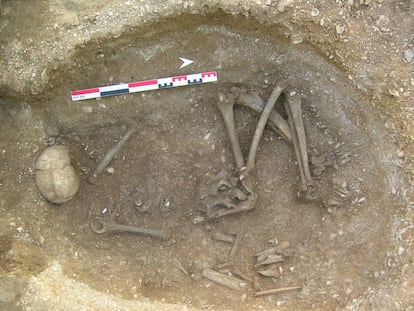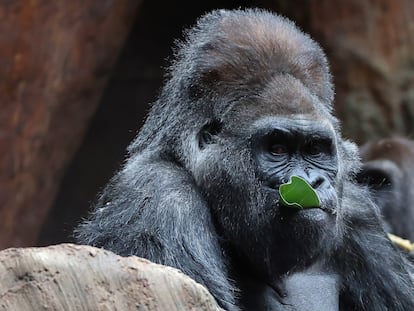The mystery of the Amazigh people in Gran Canaria, Spain
An exhibition at the country’s National Archeological Museum reveals the secrets of the Berber settlement on the island, while exploring the conquest of these pre-Hispanic peoples by the Crown of Castile in the 15th century
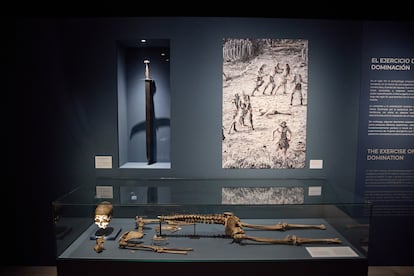

In the first century B.C., a few hundred Berbers — also known as the Amazigh people — landed on the coast of Gran Canaria, the third-largest island of the archipelago that is now known as the Canary Islands. They didn’t come alone: they brought their ceramics, the alphabet, domestic animals (including pigs, goats, sheep and dogs), seeds (barley, wheat, lentils and peas) and fig trees. Their culture soon spread throughout the island. It evolved for about 1,400 years until, in 1487, following its conquest by the Catholic Monarchs, the territory was incorporated into the Crown of Castile.
Historias de una isla. Arqueología de Gran Canaria [Stories of an Island: Archeology of Gran Canaria] is an exhibition now open to the public at Spain’s National Archaeological Museum. It recounts, through the use of original artifacts, an “exciting story from North Africa,” explains Mari Carmen Cruz de Mercadal, curator of the exhibition and of Museo Canario [the Canary Museum], where most of the objects on display come from.
The reasons that led this North African group to undertake the journey to the archipelago are unknown, although Roman pressure on what is now the region of North Africa may be one of the causes. It’s also unknown if the Berbers arrived to the Canary Islands on their own, or if they were transported by another group that was adept at sailing. Similarly, historians are unable to determine if they populated all the islands in the archipelago from the start, or if they moved from island to island over time.
The first generations of Berbers occupied ravines and mountains far from the coast — something unusual for a people who supposedly knew how to sail. “They lived in caves, in the vicinity of which they located their cemeteries,” Cruz de Mercadal recounts. Their main activity was herding. But, between the 7th and 8th centuries, new settlers from the continent arrived and pushed for agricultural development. Three centuries later, a radical change took place regarding the location of the settlements, for reasons which are unknown: the Berbers began to build stone houses on the coasts, while the caves were abandoned.

In the 11th century, the Amazigh specialized in fishing, which led to significant population growth. In fact, some skulls discovered by archeologists reveal that these peoples suffered from a bone anomaly known as auricular exostosis, which is caused by prolonged contact with cold water. “It wasn’t a serious problem. It’s the same thing that happens to surfers when they’re in icy waters; although, in the long run, [this condition] can end up affecting your hearing,” the curator notes.
The absence of metals on the island forced the Berbers to exploit obsidian to create sharp objects, while basalt and phonolite were mined to carve tools. “Obsidian was obtained in open pit mining and horizontal tunnel mines, which required collaborative work and very specific technical knowledge,” the expert adds.
For their part, imported goats, sheep and pigs from North Africa quickly adapted to the conditions of the island. They were a basic resource for subsistence, but their bones and skins also provided things such as leather, threads and needles. Meanwhile, agricultural work was fruitful, so much so that it became essential to build large storage granaries out of rock.
These pre-Hispanic inhabitants also made clay figurines for their domestic spaces. They produced a great variety in terms of postures, anatomical parts, or the representation of hair. Most of this art revolved around the concept of fertility.
“In this society,” Cruz de Mercadal explains, “the role of the community was essential to this careful work. [The Berbers] devoted time, effort and knowledge [to their crafts].” Archaeological traces are abundant, as evidenced by important bone fractures that, despite their severity, managed to heal. “[This] could only be achieved through [medical] care and by replacing the jobs that the injured person used to perform.”
In the 14th century, the first Europeans arrived in the archipelago, searching for new trade routes and sources of wealth. It was a period of evangelizing missions, slave raids and looting, which was followed by a period of conquest in the 15th century. This culminated in the incorporation of all the islands into the Crown of Castile. “The conquest and colonization had a brutal impact on the first settlers, who were decimated by war, famine and new pathogens. The social, economic and ideological system collapsed. But the Indigenous imprint remains in human genetics, mainly through maternal lineages, due to the greater survival of Indigenous women, who ended up related to a predominantly male colonizing population.” While the percentages vary according to each island, DNA tests have revealed that up to 50% of residents of the Canary Islands have some Amazigh heritage.
In the 16th century — thanks to the cultivation and export of sugar cane, highly demanded in European markets — there was strong economic activity in the archipelago. Gran Canaria specifically was located at the crossroads of major trade routes, which favored port and commercial activity.
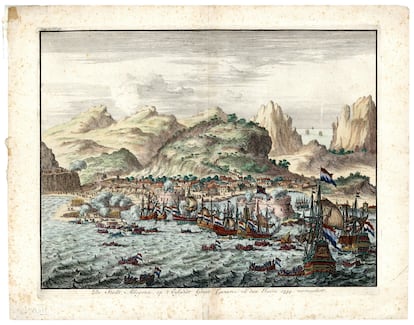
In 1599, Gran Canaria suffered a brutal attack by the privateering army of Van der Does: the Dutch mercenaries destroyed Las Palmas and forced its inhabitants to flee towards the mountains. Believing that he had won the battle, the Dutchman grew confident; he stormed the island and walked right into an ambush, leaving 1,440 corpses in his flight. In 2000, an archaeological mission to Rosarito Street in Gran Canaria revealed the remains of two members of the attacking army, who were buried in a grave dug in the sand. They were two men between the ages of 20 and 40 who suffered major injuries –—they had been pierced by six projectiles. Dying on the ship, their bodies were thrown overboard by Dutch survivors. They subsequently washed ashore and were buried face down by the islanders.
The following centuries saw epidemics brought by the ships that docked in the ports (in 1851, 10% of the population died from cholera), intense commercial activity in the 19th century (all kinds of English glass bottles have been found), the Civil War (in 2008, a 180-foot-deep well was found with a group of skeletons shot in the skull) and, finally, tourism. In 2022, the island received 3.8 million visitors — five times the resident population.
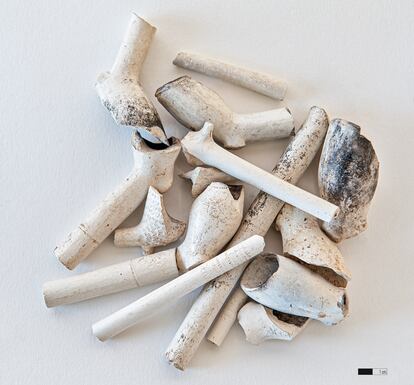
The exhibition ends in an original way, with the archaeological footprint that we will leave to the next generations. “We have placed one last display case with objects found on the island today, such as glass bottles of sparkling water, candy wrappers, a mobile phone, batteries, a computer mouse, and a toy pirate ship,” the curator chuckles. “Because of Van der Does, the privateer.”
“400 Gran Canarians fought against 8,000 Dutch. We’re much more than just sun and sand,” she concludes, fixing her gaze on a picture of an umbrella in the sand — the photograph that the exhibition tour begins with.
Sign up for our weekly newsletter to get more English-language news coverage from EL PAÍS USA Edition
Tu suscripción se está usando en otro dispositivo
¿Quieres añadir otro usuario a tu suscripción?
Si continúas leyendo en este dispositivo, no se podrá leer en el otro.
FlechaTu suscripción se está usando en otro dispositivo y solo puedes acceder a EL PAÍS desde un dispositivo a la vez.
Si quieres compartir tu cuenta, cambia tu suscripción a la modalidad Premium, así podrás añadir otro usuario. Cada uno accederá con su propia cuenta de email, lo que os permitirá personalizar vuestra experiencia en EL PAÍS.
¿Tienes una suscripción de empresa? Accede aquí para contratar más cuentas.
En el caso de no saber quién está usando tu cuenta, te recomendamos cambiar tu contraseña aquí.
Si decides continuar compartiendo tu cuenta, este mensaje se mostrará en tu dispositivo y en el de la otra persona que está usando tu cuenta de forma indefinida, afectando a tu experiencia de lectura. Puedes consultar aquí los términos y condiciones de la suscripción digital.
More information
Archived In
Últimas noticias
Trump clarifies who is ultimately in charge in Venezuela: ‘Me’
Maduro pleads not guilty before the federal court in New York: ‘I am still the president of Venezuela’
A new test can detect Alzheimer’s from a finger prick
UN team enters Sudanese city of El Fasher after paramilitary massacre: ‘It’s like a ghost town’
Most viewed
- Gilles Lipovetsky: ‘If you want to live better and fall in love, take Prozac, don’t look to philosophy’
- Alain Aspect, Nobel laureate in physics: ‘Einstein was so smart that he would have had to recognize quantum entanglement’
- Alvin Hellerstein, a 92-year-old judge appointed by Bill Clinton, to preside over Maduro’s trial in New York
- Why oil has been at the center of Venezuela-US conflicts for decades
- Cuba confirms death of 32 of its citizens in the US attack against Venezuela
